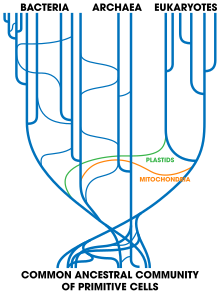基因水平轉移
| 此條目需要擴充。 (2014年2月9日) |
| 此條目需要精通或熟悉相关主题的编者参与及协助编辑。 |


基因水平轉移(英語:horizontal gene transfer,縮寫:HGT)又稱水平基因轉移或基因側向轉移(lateral gene transfer,縮寫:LGT),指生物將遺傳物質傳遞給其他細胞而非其子代的過程,例如:接合、转导及转化。與此相對,“基因垂直传递”指生物由其祖先繼承遺傳物質。遺傳學一般關心更爲普遍的垂直傳遞,但目前的知識表明,基因水平轉移是一個重要的現象[2]。由於此現象的存在,使生物早期的演化關係更為複雜。
水平基因轉移是細菌抗生素抗藥性的主要原因[3][4][5][6],並且在細菌可降解新型化合物例如人類創建的殺蟲劑進化中起著重要作用[7],並在進化,維護和傳輸毒性的重要原因 [8]。這種基因水平轉移經常涉及溫和的噬菌體和質粒[9][10]。
大多數的思維在遺傳學一直專注於垂直傳遞,但是人們日益認識到基因水平轉移是一種非常顯著的現象,以及是在單細胞生物之間或許是基因轉移主要形式[11][12]。
人工的基因水平轉移屬於基因工程的一種。
基因水平轉移生物
参考文献
- ^ Sidney K. Pierce, Xiaodong Fang, Julie A. Schwartz, Xuanting Jiang, Wei Zhao, Nicholas E. Curtis, Kevin M. Kocot, Bicheng Yang, Jian Wang. Transcriptomic Evidence for the Expression of Horizontally Transferred Algal Nuclear Genes in the Photosynthetic Sea Slug, Elysia chlorotica. Molecular Biology and Evolution. 2012-06-01, 29 (6): 1545–1556 [2018-04-02]. ISSN 0737-4038. doi:10.1093/molbev/msr316. (原始内容存档于2018-06-01) (英语).
- ^ Horizontal and vertical: The evolution of evolution - life - 26 January 2010 - New Scientist. [2010-01-29]. (原始内容存档于2015-04-02).
- ^ OECD, Safety Assessment of Transgenic Organisms, Volume 4: OECD Consensus Documents, 2010, pp.171-174
- ^ Kay E, Vogel TM, Bertolla F, Nalin R, Simonet P. In situ transfer of antibiotic resistance genes from transgenic (transplastomic) tobacco plants to bacteria. Appl. Environ. Microbiol. July 2002, 68 (7): 3345–51 [2014-02-09]. PMC 126776
 . PMID 12089013. (原始内容存档于2020-06-05).
. PMID 12089013. (原始内容存档于2020-06-05).
- ^ Koonin EV, Makarova KS, Aravind L. Horizontal gene transfer in prokaryotes: quantification and classification. Annu. Rev. Microbiol. 2001, 55: 709–742 [2014-02-09]. PMID 11544372. doi:10.1146/annurev.micro.55.1.709. (原始内容存档于2019-09-19).
- ^ Nielsen KM. Barriers to horizontal gene transfer by natural transformation in soil bacteria. APMIS Suppl. 1998, 84: 77–84. PMID 9850687.
- ^ McGowan C, Fulthorpe R, Wright A, Tiedje JM. Evidence for interspecies gene transfer in the evolution of 2,4-dichlorophenoxyacetic acid degraders. Appl. Environ. Microbiol. October 1998, 64 (10): 4089–92 [2014-02-09]. PMC 106609
 . PMID 9758850. (原始内容存档于2019-09-19).
. PMID 9758850. (原始内容存档于2019-09-19).
- ^ Eric Christopher Keen. Paradigms of pathogenesis: targeting the mobile genetic elements of disease. Frontiers in Cellular and Infection Microbiology. 2012, 2 [2018-04-02]. ISSN 2235-2988. doi:10.3389/fcimb.2012.00161 (英语).
- ^ Naik GA, Bhat LN, Chpoade BA, Lynch JM. Transfer of broad-host-range antibiotic resistance plasmids in soil microcosms. Curr. Microbiol. 1994, 28 (4): 209–215. doi:10.1007/BF01575963.
- ^ Varga M, Kuntova L, Pantucek R, Maslanova I, Ruzickova V, Doskar J. Efficient transfer of antibiotic resistance plasmids by transduction within methicillin-resistant Staphylococcus aureus USA300 clone. FEMS Microbiol. Lett. 2012, 332 (2): 146–152. PMID 22553940. doi:10.1111/j.1574-6968.2012.02589.x.
- ^ Lin Edwards. Horizontal gene transfer in microbes much more frequent than previously thought. PhysOrg.com. October 4, 2010 [2012-01-06]. (原始内容存档于2011-09-15).
- ^ Carrie Arnold. To Share and Share Alike: Bacteria swap genes with their neighbors more frequently than researchers have realized. Scientific American. April 18, 2011 [2012-01-06]. (原始内容存档于2012-11-02).
- ^ 整個世界都是我的裝備庫!來看看地表最強的水熊秘訣. PanSci 泛科學. 2015-12-02 [2017-03-09]. (原始内容存档于2017-03-25) (中文(臺灣)).
参见
| ||||||||||||||||||||||
